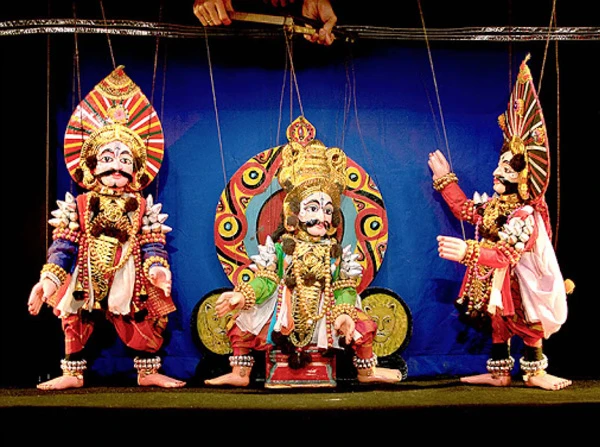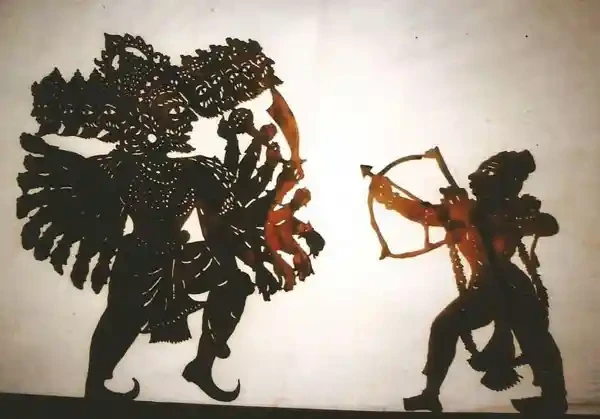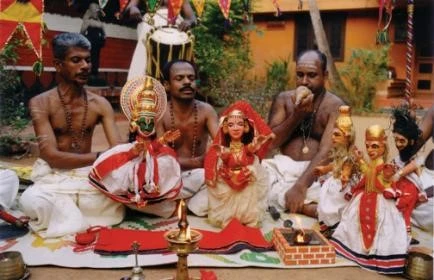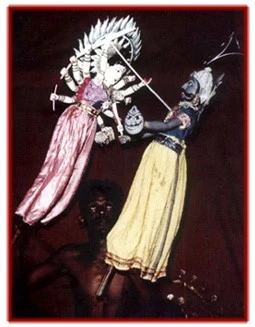India boasts various living puppetry traditions, including glove, string, rod, and shadow puppetry. Despite regional variations, these traditions share common features such as narrative material, musical accompaniment, and moral content, often intertwined with religious themes.
In this article, you will know about meaning and types of Puppetry in India, its significance and Modern context in Indian Puppetry. To explore more interesting UPSC Art & Culture topics of GS Paper -1 like Indian Puppetry, check out other articles and IAS Notes of IASToppers.
Table of Content
- Origin and Background
- Significance of Puppets
- String puppets
- Shadow Puppets
- Glove Puppets
- Rod Puppets
- Modern Indian Puppetry
- Conclusion
- Frequently Asked Questions
Origin and Background
- Puppetry is an ancient form of theatrical performance that involves the manipulation of puppets, objects, or figures to convey a story or message.
- Excavation from Harappa and Mohenjo Daro revealed puppets with attached sockets
- Puppetry has ancient roots, with evidence of its existence dating back to the 1st or 2nd century B.C. in Tamil classic ‘Silappadikaram’.
- References to puppetry in ancient Indian texts like the Mahabharata date back to around the 4th century BCE.
- The Sanskrit grammarian Panini and later scholars like Patanjali mentioned puppets in their works.
- Scholars argue that the term “sutradhara” (director of classical Sanskrit theater) may have originated from puppetry, suggesting a divine association with puppeteers.
- Legend has it that Brahma, the creator god, fashioned the first puppet to entertain his wife Goddess Saraswati.
- There are various types of puppets, including hand puppets, rod puppets, string puppets (marionettes), shadow puppets, and more.
Global Puppets:
- Hand Puppets: Operated by hand inside the puppet, controlling its head and arms.
- Finger Puppets: Small puppets that fit on a single finger and are used in storytelling and education.
- Marionettes: String puppets controlled from above by strings or wires.
- Rod Puppets: Manipulated with rods attached to the puppet’s body, often used in traditional Indonesian and Vietnamese puppetry.
- Shadow Puppets: Flat, articulated figures held between a light source and a screen, creating shadows that tell a story.
- Ventriloquist Puppets: Puppets operated by a performer who speaks without moving their lips, creating the illusion of the puppet speaking.
- Bunraku Puppets: Large, intricate Japanese puppets operated by three puppeteers.
- Glove Puppets: Similar to hand puppets but often simpler, fitting over the hand like a glove.
- Water Puppets: Vietnamese puppets performed in water, with puppeteers hidden behind a screen.
- Stick Puppets: Puppets attached to a stick, often used in educational settings and simple performances.
Significance of Puppetry in India
- Cultural Significance: It is used in storytelling, religious rituals, festivals, and entertainment. Different cultures have developed their own puppetry traditions, reflecting their beliefs, customs, and folklore.
- Artistic Expression: Puppetry is not only a form of entertainment but also a means of artistic expression where puppeteers use movement, voice, music, and visual elements.
- Educational Tool: In schools, museums, and community programs, effectively teaching children about history, literature, science, and social issues in an engaging and interactive manner.
- Evolution: It adapted to changing technological, social, and cultural contexts, incorporating multimedia, robotics, and digital effects while still preserving traditional techniques.
Puppetry in India
- Living Traditions: India boasts over twenty living puppetry traditions with regional variations but common features such as narrative material, musical accompaniment, and moral content.
- Theater Connection: Traditional puppetry forms exhibit strong connections with regional theater traditions, reflecting similar rituals, characters, and performance elements.
- Visual Art: Puppet making in India is closely linked to local visual art traditions, with similarities observed between temple mural styles and shadow puppets.
- Storytelling: Traditional puppet plays typically depict stories from ancient epics like the Ramayana and Mahabharata, as well as local myths and tales, serving as vehicles for moral and spiritual ideas.
- Generational Craft: The art of puppetry is passed down through generations, with children learning from their elders.
- Festivals and Rituals: Puppet performances are integral to festivals, rituals, and special occasions, often believed to ward off evil spirits or bring relief during times of drought.
- Diverse Forms: Puppetry, scroll paintings, and mask performances are prevalent across the country, serving as both religious tools and sources of entertainment.
String Puppets:
- String puppets, also known as marionettes, are puppets controlled from above by strings or threads attached to a control by a puppeteer or marionettist.
- Kathputli (Rajasthan): Primarily performed by the nats or bhats community, this ancient art form has deep roots in Rajasthan’s cultural landscape with wooden puppets.
- Gopalila Kundhei (Odisha): Made of light wood, Kundheis wear attire resembling Jatra performers’ costumes, they have more joints and are controlled by a triangular instrument.
- It isalso known as “cowherder-play puppet,” depicting the youthful pranks of Lord Krishna with the cowherds (gopa/gopi) and his love for Radha.
- Gombeyatta (Karnataka): Resembling Yakshagana characters, these puppets have legs and are controlled by 5-7 strings, so require multiple puppeteers to maneuver.
- Bommalattam (Tamil Nadu): Patronized by kings of Tanjavur, these large and heavy puppets combine string and rod techniques, strings are tied to an iron ring on the puppeteer’s head.
- Nool Pavakoothu (Kerala); String doll dance performances by Nair caste members were revived after facing extinction, the shows are accompanied by amusing dialogues between clowns.
- Keelu Bommalata and Sutram Bommalata (Andhra Pradesh): It include stories from Ramayana and Mahabharata, puppeteers manipulate strings attached to their heads and hands.
- Tarer Putul Nach (West Bengal): Also known as sutor putul, puppets are made from Shola pith, and draws stories from epics, Puranas, narratives from jatra or popular films.
- Laithibi Jagoi (Manipur): It focuses on Vaishnava themes, Radha and Krishna, performed as an interlude during dance performances.
Shadow Puppets:
- Shadow puppets are flat, cut-out figures that are placed between a light and a translucent screen to create the illusion of moving images.
- The puppets are often made from leather, fish skin, or cardboard and can be two-dimensional or three-dimensional.
- Ravanacchaya (Orissa): Made from deerskin, these puppets create opaque shadows whose movements require expertise and precision.
- The puppets do not have any joints, and Non-human puppets, such as trees and animals, are frequently used.
- Togalu Gombeyatta (Karnataka): Puppets vary in size based on social status, creating artistic silhouettes.
- Tholu Bommalata (Andhra Pradesh): It is a rare art featuring folk tales, epics, and Puranic stories. The Selvaraja Shadow Puppet Group and Indian Puppeteers are notable practitioners.
- Tolpava Koothu (Kerala): Performed by Vellala Chetty, Nair, and Ganka communities, it is dedicated to Goddess Durga.
- Puppeteers manipulate deerskin puppets illuminated by coconut oil lamps, and percussive music to narrate tales from the Kamba Ramayana.
- Chamdyacha Bahulya (Maharashtra): Performed by Thakar community, this leather puppetry is believed to have evolved from kithli bhavali khel (bark cloth/paper puppet play).
Glove Puppets:
- Head of such puppets are made from papier mache, cloth or wood with hands emerging below the neck, while rest of the parts are covered with long skirts.
- They are also known as sleeve, hand, or palm puppets as they are controlled by hands.
- Pavakathakali (Kerala): Developed in the 18th century, it showcases complex stories from classical Kathakali dance drama, derived from Mahabharat and Ramayana.
- Sakhi Kundhei Nata (Odisha): performed by Ahir Kelas community, mostly based on stories of Krishna and Radha, based on texts like Vastraharan and Radha Krishna Milan.
- Beni Putul (West Bengal): These are Dolls for Commercial purpose, often used as a tool of resistance against the oppression by British.
- Gulabo-Sitabo (Uttar Pradesh): Dating back to the 17th century, it features characters- Gulabo and Sitabo, two wives of the same husband, with humorous dialogues, songs, and playful fights.
Rod Puppets:
- Rod puppets are an extension of glove-puppets, but often much larger and supported and manipulated by rods from below.
- Putul Nautch (West Bengal, Assam): Carved from wood, these puppets vary in size and stylization with movement controlled by a bamboo hub tied to the puppet’s waist.
- In Assam, itreflects culture of saint-poet-social reformer Shankardeva, with roots in the 16th-century bhaona- traditional theater of Assam used to spread Vaishnavite religion.
- Salaki Gombeyata (Karnataka): Puppets are manipulated using both strings and rods, with an iron ring placed on the head of the performer to control forceful movements.
- Yampuri (Bihar): These puppets are in one piece and have no joints, so manipulation is different from other Rod puppets and requires greater dexterity.
- Kathi Kundhei Nacha (Odisha): This wooden-rod puppet dance, is a reconstructed traditional form featuring stories from epics and Puranas.
Other Puppetry influences
- Chitren Dekhavane (Picture Showing): This puppetry from Maharashtra is closely related to tradition of chitrakathi, where performers narrate stories using sequential images.
- Puppetry and related art forms are influenced by Tibetan culture, such as Sikkim, Kashmir, and Himachal Pradesh, through performances like ‘cham mask performances or lhamo dance dramas.
- While not strictly puppetry, Kerala features mask performances like kummatti and tiger dance (pulikali), where individuals visit homes to exorcise evil spirits.
Modern Indian Puppetry
Since India’s independence, puppetry has experienced a renaissance, evolving into a dynamic and multifaceted art form that reflects the complexities of modern Indian society.
Recognition and Influence:
- Government recognition through awards like the Sangeet Natak Akademi Awards and the Padmashri has bolstered the stature of contemporary puppeteers.
- Dadi Pudumjee served as the president of UNIMA International, showcasing India’s influence on the global puppetry community.
Global Influences:
- Visits by renowned puppeteers from around the world, including Bil Baird, Soviet troupes, and others, sparked interest and inspired Indian puppeteers.
- Four Indian puppeteers studied at the Central Obraztsov Puppet Theatre in Moscow, bringing back Russian rod puppetry techniques to India.
- Cross-Cultural Exchange: Foreign artists, like Michael Meschke and Massimo Schuster, create syncretic performances that blend Indian mythic tales with international artistic aesthetics.
Centers of Innovation:
- Calcutta: Emerged as a hub for modern professional puppet theater, with institutions like the Calcutta Puppet Theatre training a new generation of puppeteers.
- New Delhi: Home to Sutradhar Puppet Theatre, founded by Dadi Pudumjee, which later evolved into the Shri Ram Centre Puppet Repertory and the Ishara Puppet Theatre Trust.
- Hyderabad: Ratnamala Nori’s Nori Arts and Puppet Centre focuses on education and social change.
- Kolkata: Hiren Bhattacharya’s Peoples Puppet Theatre addresses themes of social justice.
Pioneers and Innovators:
- Raghunath Goswami: In the 1950s, Goswami created diverse puppet events through his Putulpuri Studio, later known as The Puppets, in Calcutta.
- Madhulal Master: Founded the Indian Institute of Puppetry in Bombay, pioneering large-scale rod puppet performances mixed with marionettes.
- Devilal Samar: Established the Bharathya Lok Kala Mandal Centre in Udaipur, integrating a museum, school, and puppet theater.
- Meher Contractor & Mansinh Zala: Trained in visual arts in London, she played a vital role in Ahmedabad’s puppetry scene, blending Western and Indian traditions.
- Ranjana Pandey: Founder of Jan Madhyam in New Delhi, addressing issues related to women and children.
- Anurupa Roy: Leads Katkatha Puppet Arts Trust, exploring themes of women’s situation, war, and peace.
Conclusion
Throughout India’s history, puppetry has served as a powerful medium for cultural expression, education, and entertainment, transcending religious and regional boundaries. Contemporary Indian puppetry is a dynamic fusion of tradition and innovation, driven by visionary artists who use puppetry as a powerful medium to explore social, political, and artistic themes. With government support and global recognition, Indian puppetry continues to captivate audiences worldwide, bridging cultural divides and inspiring artistic dialogue across borders.
Ref: Source-1
| Other Articles in History & Culture | |
| Folk Dances of India | Pre-Historic Paintings |
| Kathakali | Modern Indian Theatre |
| Folk Paintings of India | UNESCO World Heritage Sites |
FAQs (Frequently Asked Questions)
What is the folk puppetry of India?
The forms of puppetry prevalent in India are mainly rod, glove, string and shadow.
Why is puppetry important in India?
Puppetry throughout the ages has held an important place in traditional entertainment.





